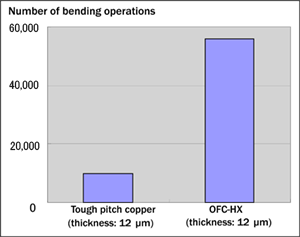2009 The former Hitachi Cable News Release
Information (including product prices, product specifications, details of services, launch dates, inquiry information, and URLs) contained in this news release is current as of the date of the press release but is subject to change without notice. Please note that details may differ from those effective on the search date.
Hitachi Cable develops "OFC-HX" surface-treated rolled copper foil with high flexibility
Hitachi Cable, Ltd. has announced the development of an OFC-HX surface-treated rolled copper foil, using oxygen-free copper (with 99.96% or higher purity), that offers more than five-fold better flexibility than conventional rolled copper made from tough pitch copper (with 99.90% or higher purity).*1 Mass production will begin in December 2009.
Rolled copper foil is made by forming a cast copper ingot into a thin film. Used primarily as a conductor on FPC*2 and as a negative current collector for lithium-ion secondary batteries, rolled copper foil offers flexibility and strength superior to electrolytic copper foil manufactured by continuously peeling a thin film of copper separated by the electrolytic process. Thanks to this superb flexibility and strength, rolled copper foil is used as a conductor in the flexing section of the FPC in cellular phones. With the shrinking size of mobile devices such as cellular phones in recent years, the space available for internal wiring, including FPC, has also shrunk. This, in turn, increases the importance of the flexibility of the rolled copper foil used for conductors on the FPC.
To meet this need, Hitachi Cable has developed an OFC-HX surface-treated rolled copper foil using oxygen-free copper. The company will begin mass production of the OFC-HX in December 2009.
The OFC-HX surface-treated rolled copper foil is made of oxygen-free copper at purities of 99.96% or higher. Since impurities can cause internal cracks, the OFC-HX, unlike conventional rolled copper foils, is made of a copper material from which every technically feasible effort has been made to remove impurities.
In addition, Hitachi Cable designed the copper crystals to align in the same direction when heat is applied during the manufacture of the copper-clad laminate that serves as the base material of the FPC. This minimizes the accumulation of metal fatigue generated by repeated flexing.
With its low impurity levels and optimized crystal alignment, the OFC-HX offers flexibility more than five-fold better than rolled copper foil made from tough pitch copper.
Hitachi Cable has also improved the uniformity of the surface roughing process treatment to achieve extremely dense irregularities on the copper foil surface. This improves adhesion to the base resin material and allows for finer conductor patterns.
Hitachi Cable will continue to focus on developing surface-treated rolled copper foils with enhanced flexibility to meet the needs of customers as part of its efforts to strengthen and expand its rolled copper foil business.
| *1 | Comparison between Hitachi Cable's OFC-HX foil (thickness: 12 µm) and tough pitch copper rolled foil (thickness: 12 µm). |
| *2 | FPC stands for Flexible Printed Circuits (flexible printed circuit boards). |
Results of bending test
(measurements taken with copper foils alone after heating at 300°C for 5 min)
(IPC-TM-650, R = 1.0 mm, testing speed: 1,500 cpm, stroke: 10 mm)
